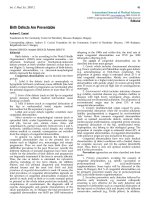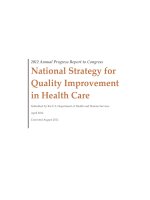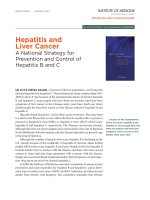Hepatitis and Liver Cancer: A National Strategy for Prevention and Control of Hepatitis B and C doc
Bạn đang xem bản rút gọn của tài liệu. Xem và tải ngay bản đầy đủ của tài liệu tại đây (1.4 MB, 253 trang )
Visit the
National Academies Press online, the authoritative source for all books from the
National Academy of Sciences, the National Academy of Engineering, the Institute of
Medicine, and the National Research Council:
• Download hundreds of free books in PDF
• Read thousands of books online, free
• Sign up to be notified when new books are published
• Purchase printed books
• Purchase PDFs
• Explore with our innovative research tools
Thank you for downloading this free PDF. If you have comments, questions or just want
more information about the books published by the National Academies Press, you may
contact our customer service department toll-free at 888-624-8373,
visit us online, or
send an email to
This free book plus thousands more books are available at
.
Copyright © National Academy of Sciences. Permission is granted for this material to be
shared for noncommercial, educational purposes, provided that this notice appears on the
reproduced materials, the Web address of the online, full authoritative version is retained,
and copies are not altered. To disseminate otherwise or to republish requires written
permission from the National Academies Press.
ISBN: 0-309-14629-1, 252 pages, 6 x 9, (2010)
This free PDF was downloaded from:
/>Hepatitis and Liver Cancer: A National Strategy for
Prevention and Control of Hepatitis B and C
Heather M. Colvin and Abigail E. Mitchell, Editors;
Committee on the Prevention and Control of Viral
Hepatitis Infections; Institute of Medicine
Copyright © National Academy of Sciences. All rights reserved.
Hepatitis and Liver Cancer: A National Strategy for Prevention and Control of Hepatitis B and C
/>Heather M. Colvin and Abigail E. Mitchell, Editors
Committee on the Prevention and Control of Viral Hepatitis Infections
Board on Population Health and Public Health Practice
H E PAT I T I S A N D
L I V E R C A N C E R
A National Strategy for Prevention and
Control of Hepatitis B and C
Copyright © National Academy of Sciences. All rights reserved.
Hepatitis and Liver Cancer: A National Strategy for Prevention and Control of Hepatitis B and C
/>THE NATIONAL ACADEMIES PRESS 500 Fifth Street, N.W. Washington, DC 20001
NOTICE: The project that is the subject of this report was approved by the Governing
Board of the National Research Council, whose members are drawn from the councils of
the National Academy of Sciences, the National Academy of Engineering, and the Institute
of Medicine. The members of the committee responsible for the report were chosen for their
special competences and with regard for appropriate balance.
This study was supported by Contract 200-2005-13434, TO#16, between the National Acad-
emy of Sciences and the Department of Health and Human Services (with support from the
Centers for Disease Control and Prevention, the Office of Minority Health, and the Depart-
ment of Veterans Affairs) and by the Task Force for Child Survival and Development on behalf
of the National Viral Hepatitis Roundtable. Any opinions, findings, conclusions, or recommen-
dations expressed in this publication are those of the author(s) and do not necessarily reflect
the view of the organizations or agencies that provided support for this project.
Library of Congress Cataloging-in-Publication Data
Hepatitis and liver cancer : a national strategy for prevention and control of hepatitis B
and C / Heather M. Colvin and Abigail E. Mitchell, editors ; Committee on the Prevention
and Control of Viral Hepatitis Infections, Board on Population Health and Public Health
Practice.
p. ; cm.
Includes bibliographical references and index.
ISBN 978-0-309-14628-9
1. Hepatitis B—United States. 2. Hepatitis C—United States. 3. Liver—Cancer—United
States. I. Colvin, Heather M. II. Mitchell, Abigail E. III. Institute of Medicine (U.S.).
Committee on the Prevention and Control of Viral Hepatitis Infections. IV. Institute of
Medicine (U.S.). Board on Population Health and Public Health Practice. V. National
Academies Press (U.S.)
[DNLM: 1. Hepatitis B—complications—United States. 2. Hepatitis B—prevention &
control—United States. 3. Hepatitis C—complications—United States. 4. Hepatitis C—
prevention & control—United States. 5. Liver Neoplasms—prevention & control—United
States. 6. Viral Hepatitis Vaccines—therapeutic use—United States. WC 536 H5322 2010]
RA644.H4H37 2010
616.99'436—dc22
2010003194
Additional copies of this report are available from the National Academies Press, 500 Fifth
Street, N.W., Lockbox 285, Washington, DC 20055; (800) 624-6242 or (202) 334-3313 (in
the Washington metropolitan area); Internet, .
For more information about the Institute of Medicine, visit the IOM home page at www.
iom.edu.
Copyright 2010 by the National Academy of Sciences. All rights reserved.
Printed in the United States of America
The serpent has been a symbol of long life, healing, and knowledge among almost all cultures
and religions since the beginning of recorded history. The serpent adopted as a logotype by
the Institute of Medicine is a relief carving from ancient Greece, now held by the Staatliche
Museen in Berlin.
Suggested citation: IOM (Institute of Medicine). 2010. Hepatitis and Liver Cancer: A National
Strategy for Prevention and Control of Hepatitis B and C. Washington, DC: The National
Academies Press.
Copyright © National Academy of Sciences. All rights reserved.
Hepatitis and Liver Cancer: A National Strategy for Prevention and Control of Hepatitis B and C
/>“Knowing is not enough; we must apply.
Willing is not enough; we must do.”
—Goethe
Advising the Nation. Improving Health.
Copyright © National Academy of Sciences. All rights reserved.
Hepatitis and Liver Cancer: A National Strategy for Prevention and Control of Hepatitis B and C
/>The National Academy of Sciences is a private, nonprofit, self-perpetuating society
of distinguished scholars engaged in scientific and engineering research, dedicated to
the furtherance of science and technology and to their use for the general welfare.
Upon the authority of the charter granted to it by the Congress in 1863, the Acad-
emy has a mandate that requires it to advise the federal government on scientific
and technical matters. Dr. Ralph J. Cicerone is president of the National Academy
of Sciences.
The National Academy of Engineering was established in 1964, under the charter
of the National Academy of Sciences, as a parallel organization of outstanding en-
gineers. It is autonomous in its administration and in the selection of its members,
sharing with the National Academy of Sciences the responsibility for advising the
federal government. The National Academy of Engineering also sponsors engineer-
ing programs aimed at meeting national needs, encourages education and research,
and recognizes the superior achievements of engineers. Dr. Charles M. Vest is presi-
dent of the National Academy of Engineering.
The Institute of Medicine was established in 1970 by the National Academy of
Sciences to secure the services of eminent members of appropriate professions in
the examination of policy matters pertaining to the health of the public. The Insti-
tute acts under the responsibility given to the National Academy of Sciences by its
congressional charter to be an adviser to the federal government and, upon its own
initiative, to identify issues of medical care, research, and education. Dr. Harvey V.
Fineberg is president of the Institute of Medicine.
The National Research Council was organized by the National Academy of Sci-
ences in 1916 to associate the broad community of science and technology with the
Academy’s purposes of furthering knowledge and advising the federal government.
Functioning in accordance with general policies determined by the Academy, the
Council has become the principal operating agency of both the National Academy
of Sciences and the National Academy of Engineering in providing services to the
government, the public, and the scientific and engineering communities. The Coun-
cil is administered jointly by both Academies and the Institute of Medicine. Dr.
Ralph J. Cicerone and Dr. Charles M. Vest are chair and vice chair, respectively, of
the National Research Council.
www.national-academies.org
Copyright © National Academy of Sciences. All rights reserved.
Hepatitis and Liver Cancer: A National Strategy for Prevention and Control of Hepatitis B and C
/>v
COMMITTEE ON THE PREVENTION AND
CONTROL OF VIRAL HEPATITIS INFECTIONS
R. Palmer Beasley (Chair), Ashbel Smith Professor and Dean Emeritus,
University of Texas, School of Public Health, Houston, Texas
Harvey J. Alter, Chief, Infectious Diseases Section, Department of
Transfusion Medicine, National Institutes of Health, Bethesda, Maryland
Margaret L. Brandeau, Professor, Department of Management Science
and Engineering, Stanford University, Stanford, California
Daniel R. Church, Epidemiologist and Adult Viral Hepatitis Coordinator,
Bureau of Infectious Disease Prevention, Response, and Services,
Massachusetts Department of Health, Jamaica Plain, Massachusetts
Alison A. Evans, Assistant Professor, Department of Epidemiology
and Biostatistics, Drexel University School of Public Health,
Drexel Institute of Biotechnology and Viral Research, Doylestown,
Pennsylvania
Holly Hagan, Senior Research Scientist, College of Nursing, New York
University, New York
Sandral Hullett, CEO and Medical Director, Cooper Green Hospital,
Birmingham, Alabama
Stacene R. Maroushek, Staff Pediatrician, Department of Pediatrics,
Hennepin County Medical Center, Minneapolis, Minnesota
Randall R. Mayer, Chief, Bureau of HIV, STD, and Hepatitis, Iowa
Department of Public Health, Des Moines, Iowa
Brian J. McMahon, Medical Director, Liver Disease and Hepatitis
Program, Alaska Native Tribal Health Consortium, Anchorage, Alaska
Martín Jose Sepúlveda, Vice President, Integrated Health Services,
International Business Machines Corporation, Somers, New York
Samuel So, Lui Hac Minh Professor, Asian Liver Center, Stanford
University School of Medicine, Stanford, California
David L. Thomas, Chief, Division of Infectious Diseases, Department of
Medicine, Johns Hopkins School of Medicine, Baltimore, Maryland
Lester N. Wright, Deputy Commissioner and Chief Medical Officer, New
York Department of Correctional Services, Albany, New York
Study Staff
Abigail E. Mitchell, Study Director
Heather M. Colvin, Program Officer
Kathleen M. McGraw, Senior Program Assistant
Norman Grossblatt, Senior Editor
Rose Marie Martinez, Director, Board on Population Health and Public
Health Practice
Copyright © National Academy of Sciences. All rights reserved.
Hepatitis and Liver Cancer: A National Strategy for Prevention and Control of Hepatitis B and C
/>Copyright © National Academy of Sciences. All rights reserved.
Hepatitis and Liver Cancer: A National Strategy for Prevention and Control of Hepatitis B and C
/>vii
Reviewers
T
his report has been reviewed in draft form by persons chosen for
their diverse perspectives and technical expertise, in accordance with
procedures approved by the National Research Council’s (NRC’s)
Report Review Committee. The purpose of this independent review is to
provide candid and critical comments that will assist the institution in mak-
ing its published report as sound as possible and to ensure that the report
meets institutional standards for objectivity, evidence, and responsiveness
to the study charge. The review comments and draft manuscript remain
confidential to protect the integrity of the deliberative process. We wish to
thank the following individuals for their review of this report:
Scott Allen, Brown University Medical School
Jeffrey Caballero, Association of Asian Pacific Community Health
Organizations
Colleen Flanigan, New York State Department of Health
James Jerry Gibson, South Carolina Department of Health and
Environmental Control
Fernando A. Guerra, San Antonio Metropolitan Health District
Theodore Hammett, Abt Associates Inc.
Jay Hoofnagle, National Institute of Diabetes and Digestive and
Kidney Diseases
Charles D. Howell, University of Maryland School of Medicine
Walter A. Orenstein, Bill & Melinda Gates Foundation
Philip E. Reichert, Florida Department of Health
Charles M. Rice III, The Rockefeller University
Copyright © National Academy of Sciences. All rights reserved.
Hepatitis and Liver Cancer: A National Strategy for Prevention and Control of Hepatitis B and C
/>viii REVIEWERS
Tracy Swan, Treatment Action Group
Su Wang, Charles B. Wang Community Health Center
John B. Wong, Tufts Medical Center
Although the reviewers listed above have provided many constructive
comments and suggestions, they were not asked to endorse the conclusions
or recommendations, nor did they see the final draft of the report before
its release. The review of the report was overseen by Bradford H. Gray,
Senior Fellow, The Urban Institute, and Elena O. Nightingale, Scholar-in-
Residence, Institute of Medicine. Appointed by the Institute of Medicine
and the National Research Council, they were responsible for making cer-
tain that an independent examination of the report was carried out in ac-
cordance with institutional procedures and that all review comments were
carefully considered. Responsibility for the final content of the report rests
entirely with the author committee and the institution.
Copyright © National Academy of Sciences. All rights reserved.
Hepatitis and Liver Cancer: A National Strategy for Prevention and Control of Hepatitis B and C
/>ix
Acknowledgments
T
he committee acknowledges the valuable contributions made by the
many persons who shared their experience and knowledge with the
committee. The committee appreciates the time and insight of the pre-
senters during the public sessions: John Ward, Dale Hu, Cindy Weinbaum,
and David Bell, Centers for Disease Control and Prevention; Chris Taylor
and Martha Saly, National Viral Hepatitis Roundtable; Lorren Sandt, Car-
ing Ambassadors Program; Joan Block, Hepatitis B Foundation; Gary
Heseltine, Council of State and Territorial Epidemiologists; William Rogers,
Centers for Medicare and Medicaid Services; Tanya Pagán Raggio Ashley,
Health Resources Services Administration; Carol Craig, National Associa-
tion of Community Health Centers; Daniel Raymond, Harm Reduction
Coalition; and Mark Kane, formerly of the Children’s Vaccine Program,
PATH. We are also grateful for the thoughtful written and verbal testimony
provided by members of the public affected by hepatitis B or hepatitis C.
Several persons contributed their expertise for this report. The com-
mittee thanks David Hutton, of the Department of Management Science
and Engineering at Stanford University; Victor Toy, Beverly David, and
Kathleen Tarleton, of IBM; Shiela Strauss, of the New York University
College of Nursing; Ellen Chang and Stephanie Chao, of the Asian Liver
Center at Stanford University; Gillian Haney, of the Massachusetts Depart-
ment of Public Health; and all the State Adult Viral Hepatitis Prevention
Coordinators that provided information to the committee.
This report would not have been possible without the diligent assistance
of Jeffrey Efird and Daniel Riedford, of the Centers for Disease Control and
Copyright © National Academy of Sciences. All rights reserved.
Hepatitis and Liver Cancer: A National Strategy for Prevention and Control of Hepatitis B and C
/>x ACKNOWLEDGMENTS
Prevention. We appreciate the assistance of Ronald Valdiserri, of the De-
partment of Veterans Affairs, for providing literature for the report.
The committee thanks the staff members of the Institute of Medicine,
the National Research Council, and the National Academies Press who
contributed to the development, production, and dissemination of this
report. The committee thanks the study director, Abigail Mitchell, and
program officer Heather Colvin for their work in navigating this complex
topic and Kathleen McGraw for her diligent management of the committee
logistics.
This report was made possible by the support of the Division of Viral
Hepatitis and Division of Cancer Prevention and Control of the Centers
for Disease Control and Prevention, the Department of Health and Human
Services Office of Minority Health, the Department of Veterans Affairs, and
the National Viral Hepatitis Roundtable.
Copyright © National Academy of Sciences. All rights reserved.
Hepatitis and Liver Cancer: A National Strategy for Prevention and Control of Hepatitis B and C
/>xi
Contents
ACRONYMS AND ABBREVIATIONS xvii
SUMMARY 1
The Charge to the Committee, 2
Findings and Recommendations, 2
Surveillance, 3
Knowledge and Awareness, 8
Immunization, 9
Viral Hepatitis Services, 12
Recommendation Outcomes, 17
1 INTRODUCTION 19
Prevalence and Incidence of Hepatitis B and Hepatitis C
Worldwide, 22
Prevalence and Incidence of Hepatitis B and Hepatitis C
in the United States, 25
Hepatitis B, 25
Hepatitis C, 28
Liver Cancer and Liver Disease from Chronic Hepatitis B Virus and
Hepatitis C Virus Infections, 29
The Committee’s Task, 30
The Committee’s Approach to Its Task, 32
References, 35
Copyright © National Academy of Sciences. All rights reserved.
Hepatitis and Liver Cancer: A National Strategy for Prevention and Control of Hepatitis B and C
/>xii CONTENTS
2 SURVEILLANCE 41
Applications of Surveillance Data, 43
Outbreak Detection and Control, 44
Resource Allocation, 45
Programmatic Design and Evaluation, 45
Linking Patients to Care, 45
Disease-Specific Issues Related to Viral-Hepatitis Surveillance, 46
Identifying Acute Infections, 47
Identifying Chronic Infections, 51
Identifying Perinatal Hepatitis B, 54
Other Challenges for Hepatitis B and Hepatitis C Surveillance
Systems, 56
Infrastructure and Process-Specific Issues with Surveillance, 57
Funding Sources, 58
Program Design, 59
Reporting Systems and Requirements, 59
Capturing Data on At-Risk Populations, 61
Case Evaluation, Followup, and Partner Services, 62
Recommendations, 63
Model for Surveillance, 66
Core Surveillance, 67
Targeted Surveillance, 71
References, 72
3 KNOWLEDGE AND AWARENESS ABOUT CHRONIC
HEPATITIS B AND HEPATITIS C 79
Knowledge and Awareness Among Health-Care and Social-Service
Providers, 80
Hepatitis B, 81
Hepatitis C, 83
Recommendation, 85
Community Knowledge and Awareness, 89
Hepatitis B, 89
Hepatitis C, 93
Recommendation, 96
References, 101
4 IMMUNIZATION 109
Hepatitis B Vaccine, 109
Current Vaccination Recommendations, Requirements, and
Rates, 110
Immunization-Information Systems, 126
Copyright © National Academy of Sciences. All rights reserved.
Hepatitis and Liver Cancer: A National Strategy for Prevention and Control of Hepatitis B and C
/>CONTENTS xiii
Barriers to Hepatitis B Vaccination, 127
Hepatitis C Vaccine, 136
Feasibility of Preventing Chronic Hepatitis C, 136
Need for a Vaccine to Prevent Chronic Hepatitis C, 137
Cost Effectiveness of a Hepatitis C Vaccine, 137
References, 138
5 VIRAL HEPATITIS SERVICES 147
Current Status, 148
Components of Viral Hepatitis Services, 154
Identification of Infected Persons, 154
Prevention, 166
Medical Management, 166
Major Gaps in Services, 170
General Population, 170
Foreign-Born People, 173
Illicit-Drug Users, 175
Pregnant Women, 181
Correctional Settings, 184
Community Health Facilities, 186
Targeting Settings That Serve At-Risk Populations, 189
References, 192
A COMMITTEE BIOGRAPHIES 209
B PUBLIC MEETING AGENDAS 215
BOXES, FIGURES, AND TABLES
Boxes
S-1 Recommendations, 4
2-1 Role of Disease Surveillance, 42
2-2 CDC Acute Hepatitis B Case Definition, 48
2-3 CDC Acute Hepatitis C Case Definition, 49
2-4 CDC Chronic Hepatitis B Case Definition, 52
2-5 CDC Hepatitis C Virus Infection Case Definition
(Past or Present), 53
2-6 CDC Perinatal Hepatitis B Virus Infection Case Definition, 55
3-1 Geographic Regions That Have Intermediate and High Hepatitis B
Virus Endemicity, 81
Copyright © National Academy of Sciences. All rights reserved.
Hepatitis and Liver Cancer: A National Strategy for Prevention and Control of Hepatitis B and C
/>xiv CONTENTS
4-1 Summary of ACIP Hepatitis B Vaccination Recommendations, 112
5-1 Summary of Recommendations Regarding Viral Hepatitis
Services, 148
5-2 Mission Statement of Centers for Disease Control and Prevention
Division of Viral Hepatitis, 150
5-3 Components of Comprehensive Viral Hepatitis Services, 155
5-4 Summary of CDC At-Risk Populations for Hepatitis B Virus
Infection, 156
5-5 Summary of CDC At-Risk Populations for Hepatitis C Virus
Infection, 158
5-6 Hepatitis B Virus-Specific Antigens and Antibodies Used for
Testing, 160
Figures
1-1 Approximate global preventable death rate from selected infectious
diseases and other causes, 2003, 20
1-2 The committee’s approach to its task, 34
2-1 Natural progression of hepatitis B infection, 46
2-2 Natural progression of hepatitis C infection, 47
4-1 Estimated cost of adult hepatitis B vaccination per quality adjusted
life year (QALY) gained for different age groups and different rates
of acute hepatitis B virus (HBV) infection incidence, 119
4-2 Trends in private health-insurance coverage, 133
5-1 Hepatitis B services model, 157
5-2 Essential viral hepatitis services for illicit-drug users, 180
Tables
1-1 Key Characteristics of Hepatitis B and Hepatitis C, 21
1-2 Burden of Selected Serious Chronic Viral Infections in the United
States, 26
4-1 Hepatitis B Vaccine Schedules for Newborns, by Maternal HBsAg
Status—ACIP Recommendations, 114
4-2 Hepatitis B Immunization Management of Preterm Infants Who
Weigh Less Than 2,000 g, by Maternal HBsAg Status—ACIP
Recommendations, 115
Copyright © National Academy of Sciences. All rights reserved.
Hepatitis and Liver Cancer: A National Strategy for Prevention and Control of Hepatitis B and C
/>CONTENTS xv
4-3 Estimated Chance That an Acute Hepatitis B Infection Becomes
Chronic with Age, 118
4-4 Studies of Hepatitis B Vaccination Rates in Injection-Drug
Users, 122
4-5 Public Health-Insurance Plans, 130
5-1 Summary of Adult Viral Hepatitis Prevention Coordinators
Survey, 153
5-2 Interpretation of Hepatitis B Serologic Diagnostic Test
Results, 161
5-3 Interpretation of Hepatitis C Virus Diagnostic Test Results, 164
5-4 Studies of Association Between Opiate Substitution Treatment and
Hepatitis C Virus Seroconversion, 178
Copyright © National Academy of Sciences. All rights reserved.
Hepatitis and Liver Cancer: A National Strategy for Prevention and Control of Hepatitis B and C
/>Copyright © National Academy of Sciences. All rights reserved.
Hepatitis and Liver Cancer: A National Strategy for Prevention and Control of Hepatitis B and C
/>xvii
Acronyms and Abbreviations
AASLD American Association for the Study of Liver Diseases
ACIP Advisory Committee on Immunization Practices
ACOG American College of Obstetricians and Gynecologists
AHRQ Agency for Healthcare Research and Quality
AIDS acquired immunodeficiency syndrome
ALT alanine aminotransferase
anti-HBc Hepatitis B core antibody
anti-HBs Hepatitis B surface antibody
anti-HCV Hepatitis C antibody
API Asian and Pacific Islander
AST aspartate transaminase
AVHPC adult viral hepatitis prevention coordinators
CDC Centers for Disease Control and Prevention
CHIP Children’s Health Insurance Program
CI confidence interval
CIA enhanced chemiluminescence
CMS Centers for Medicare and Medicaid Services
DIS disease intervention specialist
DTaP diptheria and tetanus toxoids and acellular pertussis
adsorbed vaccine
DUIT drug user intervention trial
DVH Division of Viral Hepatitis
Copyright © National Academy of Sciences. All rights reserved.
Hepatitis and Liver Cancer: A National Strategy for Prevention and Control of Hepatitis B and C
/>xviii ACRONYMS AND ABBREVIATIONS
EIA enzyme immunoassay
EIP Emerging Infections Program
EPSDT early periodic screening diagnosis and treatment program
FDA Food and Drug Administration
FEHBP Federal Employee Health Benefit Program
FQHC federally qualified health center
HAV Hepatitis A virus
HBIG Hepatitis B immunoglobulin
HBsAg Hepatitis B surface antigen
HBV Hepatitis B virus
HCC hepatocellular carcinoma
HCV Hepatitis C virus
HCW health-care workers
HDHP high deductable health plan
HIAA Health Insurance Association of America
HIB haemophilus influenzae type B
HIV human immunodeficiency virus
HMO health maintenance organization
HPV human papilloma virus
HRSA Health Resources and Services Administration
IDU injection-drug user
IIS immunization information systems
IOM Institute of Medicine
IPV inactivated polio virus
MMTP methadone maintenance treatment program
NASTAD National Alliance of State and Territorial AIDS Directors
NAT nucleic acid test
NCHHSTP National Center for HIV/AIDS, Viral Hepatitis, Sexually
Transmitted Diseases, and Tuberculosis Prevention
NEDSS National Electronic Disease Surveillance System
NETSS National Electronic Telecommunications System for
Surveillance
NGO nongovernmental organization
NHANES National Health and Nutrition Examination Survey
NIDU non-injection-drug user
NVAC National Vaccine Advisory Committee
Copyright © National Academy of Sciences. All rights reserved.
Hepatitis and Liver Cancer: A National Strategy for Prevention and Control of Hepatitis B and C
/>ACRONYMS AND ABBREVIATIONS xix
OB/GYN obstetrician/gynecologist
OMH Office of Minority Health
OR odds ratio
PEI peer education intervention
PHIN Public Health Information Network
POS point of service
PPO preferred provider organization
PY person year
QALY quality adjusted life year
RCT randomized clinical trial
RIBA recombinant immunoblot assay
RNA ribonucleic acid
RSV respiratory syncytial virus
SAMHSA Substance Abuse and Mental Health Services
Administration
SARS severe acute respiratory syndrome
SEP syringe exchange program
STD sexually transmitted disease
STRIVE Study To Reduce Intravenous Exposures
TB tuberculosis
TCM traditional Chinese medicine
USPHS US Public Health Service
USPSTF US Preventive Services Task Force
VA Department of Veterans Affairs
vCJD variant Creutzfeldt-Jakob disease
VFC Vaccines for Children
WHO World Health Organization
Copyright © National Academy of Sciences. All rights reserved.
Hepatitis and Liver Cancer: A National Strategy for Prevention and Control of Hepatitis B and C
/>Copyright © National Academy of Sciences. All rights reserved.
Hepatitis and Liver Cancer: A National Strategy for Prevention and Control of Hepatitis B and C
/>1
Summary
I
n the next 10 years, about 150,000 people in the United States will die
from liver cancer and end-stage liver disease associated with chronic
hepatitis B and hepatitis C. It is estimated that 3.5–5.3 million people—
1–2% of the US population—are living with chronic hepatitis B virus
(HBV) or hepatitis C virus (HCV) infections. Of those, 800,000 to 1.4 mil-
lion have chronic HBV infections, and 2.7–3.9 million have chronic HCV
infections. Chronic viral hepatitis infections are 3–5 times more frequent
than HIV in the United States.
Because of the asymptomatic nature of chronic hepatitis B and hepatitis
C, most people infected with HBV and HCV are not aware that they have
been infected until they have symptoms of cirrhosis or a type of liver cancer,
hepatocellular carcinoma (HCC), many years later. About 65% and 75% of
the infected population are unaware that they are infected with HBV and
HCV, respectively. Importantly, the prevention of chronic hepatitis B and
chronic hepatitis C prevents the majority of HCC cases because HBV and
HCV are the leading causes of this type of cancer.
Although the incidence of acute HBV infection is declining in the
United States, due to the availability of hepatitis B vaccines, about 43,000
new acute HBV infections still occur each year. Of those new infections,
about 1,000 infants acquire the infection during birth from their HBV-
positive mothers. HBV is also transmitted by sexual contact with an in-
fected person, sharing injection drug equipment, and needlestick injuries.
African American adults have the highest rate of acute HBV infection in
the United States and the highest rates of acute HBV infection occur in the
southern region. People from Asia and the Pacific Islands comprise the larg-
Copyright © National Academy of Sciences. All rights reserved.
Hepatitis and Liver Cancer: A National Strategy for Prevention and Control of Hepatitis B and C
/>2 HEPATITIS AND LIVER CANCER
est foreign-born population that is at risk for chronic HBV infection. The
number of people in the United States who are living with chronic HBV
infection may be increasing as a result of immigration from highly endemic
countries. On the basis of immigration patterns in the last decade, it is esti-
mated that every year 40,000–45,000 people from HBV-endemic countries
enter the United States legally.
There is no vaccine for hepatitis C. HCV is efficiently transmitted by
direct percutaneous exposure to infectious blood. Persons likely to have
chronic HCV infection include those who received a blood transfusion be-
fore 1992 and past or current injection-drug users (IDUs). Most IDUs in the
United States have serologic evidence of HCV infection (that is, they have
been exposed to HCV at some time). While HCV incidence appears to have
declined over the last decade, a large portion of IDUs, who often do not
have access to health-care services, are not identified by current surveillance
systems making interpretation of that trend complicated. African Ameri-
cans and Hispanics have a higher rate of HCV infection than whites.
THE CHARGE TO THE COMMITTEE
Despite federal, state, and local public health efforts to prevent and
control hepatitis B and hepatitis C, these diseases remain serious health
problems in the United States. Therefore, the Centers for Disease Control
and Prevention (CDC) in conjunction with the Department of Health and
Human Services Office of Minority Health, the Department of Veterans
Affairs, and the National Viral Hepatitis Roundtable sought guidance from
the Institute of Medicine (IOM) in identifying missed opportunities related
to the prevention and control of HBV and HCV infections. IOM was asked
to focus on hepatitis B and hepatitis C because they are common in the
United States and can lead to chronic disease. The charge to the committee
follows.
The IOM will form a committee to determine ways to reduce new HBV
and HCV infections and the morbidity and mortality related to chronic
viral hepatitis. The committee will assess current prevention and control
activities and identify priorities for research, policy, and action. The com-
mittee will highlight issues that warrant further investigations and oppor-
tunities for collaboration between private and public sectors.
FINDINGS AND RECOMMENDATIONS
Upon reviewing evidence on the prevention and control of hepatitis B
and hepatitis C, the committee identified the underlying factors that impede
current efforts to prevent and control these diseases. Three major factors
were found:
Copyright © National Academy of Sciences. All rights reserved.
Hepatitis and Liver Cancer: A National Strategy for Prevention and Control of Hepatitis B and C
/>SUMMARY 3
1. There is a lack of knowledge and awareness about chronic viral
hepatitis on the part of health-care and social-service providers.
2. There is a lack of knowledge and awareness about chronic viral
hepatitis among at-risk populations, members of the public, and
policy-makers.
3. There is insufficient understanding about the extent and seriousness
of this public-health problem, so inadequate public resources are
being allocated to prevention, control, and surveillance programs.
That situation has created several consequences:
• Inadequate disease surveillance systems underreport acute and
chronic infections, so the full extent of the problem is unknown.
• At-risk people do not know that they are at risk or how to prevent
becoming infected.
• At-risk people may not have access to preventive services.
• Chronically infected people do not know that they are infected.
• Many health-care providers do not screen people for risk factors
or do not know how to manage infected people.
• Infected people often have inadequate access to testing, social sup-
port, and medical management services.
To address those consequences, the committee offers recommendations
in four categories: surveillance, knowledge and awareness, immunization,
and services for viral hepatitis. The recommendations are discussed below,
and listed in Box S-1.
Surveillance
The viral hepatitis surveillance system in the United States is highly
fragmented and poorly developed. As a result, surveillance data do not pro-
vide accurate estimates of the current burden of disease, are insufficient for
program planning and evaluation, and do not provide the information that
would allow policy-makers to allocate sufficient resources to viral hepatitis
prevention and control programs. The federal government has provided
few resources—in the form of guidance, funding, and oversight—to local
and state health departments to perform surveillance for viral hepatitis.
Additional funding sources for surveillance, such as funding from states
and cities, vary among jurisdictions. The committee found little published
information on or systematic review of viral hepatitis surveillance in the
United States and offers the following recommendation to determine the
current status of the surveillance system:
Copyright © National Academy of Sciences. All rights reserved.
Hepatitis and Liver Cancer: A National Strategy for Prevention and Control of Hepatitis B and C
/>4 HEPATITIS AND LIVER CANCER
BOX S-1
Recommendations
Chapter 2: Surveillance
• 2-1. The Centers for Disease Control and Prevention should conduct
a comprehensive evaluation of the national hepatitis B and
hepatitis C public-health surveillance system.
• 2-2. The Centers for Disease Control and Prevention should develop
specific cooperative viral-hepatitis agreements with all state and
territorial health departments to support core surveillance for
acute and chronic hepatitis B and hepatitis C.
• 2-3. The Centers for Disease Control and Prevention should support
and conduct targeted active surveillance, including serologic
testing, to monitor incidence and prevalence of hepatitis B virus
and hepatitis C virus infections in populations not fully captured
by core surveillance.
Chapter 3: Knowledge and Awareness about Chronic Hepatitis B
and Hepatitis C
• 3-1. The Centers for Disease Control and Prevention should work
with key stakeholders (other federal agencies, state and local
governments, professional organizations, health-care organiza-
tions, and educational institutions) to develop hepatitis B and
hepatitis C educational programs for health-care and social-
service providers.
• 3-2. The Centers for Disease Control and Prevention should work
with key stakeholders to develop, coordinate, and evaluate inno-
vative and effective outreach and education programs to target
at-risk populations and to increase awareness in the general
population about hepatitis B and hepatitis C.
Chapter 4: Immunization
• 4-1. All infants weighing at least 2,000 grams and born to hepati-
tis B surface antigen-positive women should receive single-
antigen hepatitis B vaccine and hepatitis B immune globulin in
the delivery room as soon as they are stable and washed. The
recommendations of the Advisory Committee on Immunization
Practices should remain in effect for all other infants.
• 4-2. All states should mandate that the hepatitis B vaccine se-
ries be completed or in progress as a requirement for school
attendance.
• 4-3. Additional federal and state resources should be devoted to
increasing hepatitis B vaccination of at-risk adults.
• 4-4. States should be encouraged to expand immunization-information
systems to include adolescents and adults.
• 4-5. Private and public insurance coverage for hepatitis B vaccina-
tion should be expanded.
• 4-6. The federal government should work to ensure an adequate,
accessible, and sustainable hepatitis B vaccine supply.
• 4-7. Studies to develop a vaccine to prevent chronic hepatitis C virus
infection should continue.
Chapter 5: Viral Hepatitis Services
• 5-1. Federally funded health-insurance programs—such as Medi-
care, Medicaid, and the Federal Employees Health Benefits
Program—should incorporate guidelines for risk-factor screen-
ing for hepatitis B and hepatitis C as a required core compo-
nent of preventive care so that at-risk people receive serologic
testing for hepatitis B virus and hepatitis C virus and chronically
infected patients receive appropriate medical management.
• 5-2. The Centers for Disease Control and Prevention, in conjunction
with other federal agencies and state agencies, should provide
resources for the expansion of community-based programs that
provide hepatitis B screening, testing, and vaccination services
that target foreign-born populations.
• 5-3. Federal, state, and local agencies should expand programs to
reduce the risk of hepatitis C virus infection through injection-
drug use by providing comprehensive hepatitis C virus preven-
tion programs. At a minimum, the programs should include
access to sterile needle syringes and drug-preparation equip-
ment because the shared use of these materials has been
shown to lead to transmission of hepatitis C virus.
• 5-4. Federal and state governments should expand services to
reduce the harm caused by chronic hepatitis B and hepati-
tis C. The services should include testing to detect infection,
counseling to reduce alcohol use and secondary transmission,
hepatitis B vaccination, and referral for or provision of medical
management.
• 5-5. Innovative, effective, multicomponent hepatitis C virus preven-
tion strategies for injection-drug users and non-injection-drug
users should be developed and evaluated to achieve greater
control of hepatitis C virus transmission.
• 5-6. The Centers for Disease Control and Prevention should pro-
vide additional resources and guidance to perinatal hepatitis B









